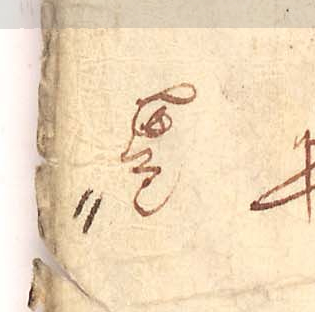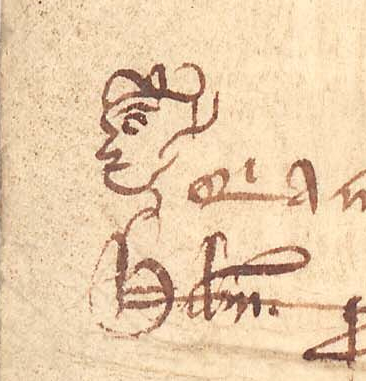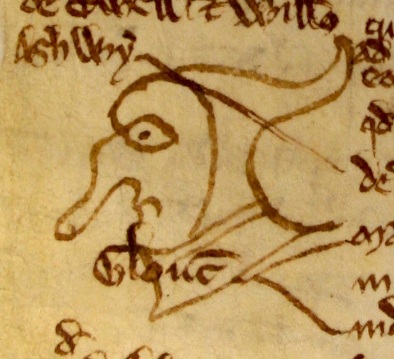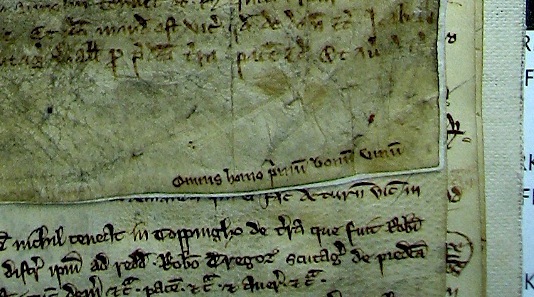Fine of the Month: June 2008
(Richard Cassidy)
1. Marginal characters and comments in the rolls
This month Richard Cassidy turns his attention to some of the more unusual features of medieval governmental documentation – the drawings and comments made by scribes outside the main body of their text. He shows that the mundane business of creating the record could be lightened with humour, gossip, and perhaps the playing out of friendly or backbiting relationships.
⁋1Little attention has been paid to marginalia in official records, rather than in illuminated manuscripts of a devotional or literary nature. 1 Andrew Hershey catalogued drawings in thirteenth-century plea rolls and memoranda rolls, and Ben Wild examined those in Henry III’s early fine rolls. 2 Their studies show that clerks could use marginal drawings to draw attention to important matters, as memonics to link related topics, or simply for fun.
⁋2Since Ben Wild wrote, many more images of fine rolls have become available online, providing more examples of marginalia. The simplest is the pointing hand, 3 indicating an entry requiring particular attention. In this case it is a fine of 100 m. from the Master of the Order of Sempringham: 4
-

- Manicule, E 371/4, m. 2.
⁋3There are also examples of indexing or mnemonic marks, whose meaning is now obscure. This sign appears next to an entry concerning Margaret, who was the wife of Charles de la Warderobe: 5
-

- Mnemonic mark, C 60/38, m. 10.
⁋4Why should the fine roll clerk mark out an apparently trivial entry – Margaret owed only half a mark, for a false claim? Perhaps her late husband’s name shows a connection to the royal wardrobe, and he was known personally to the Chancery clerk writing the roll.
⁋5Other marginal drawings seem unlikely to be official. One fine roll has two caricatures in its margins. The first is next to an entry about payments to the lepers of Harbledown. 6 If this is meant as one of the lepers, he seems none too pleased:
-

- Head in profile, C 60/34, m. 13.
⁋6The other is surely a personal comment. This caricature accompanies an entry for Thomas, son of John de Malling, the king’s barber: 7
-

- Head in profile, C 60/34, m. 2.
⁋7In the following year’s roll, there is a head in profile, possibly crowned:
-

- Head in profile, crowned, C 60/35, m. 11.
⁋8One can only speculate as to why this caricature appears next to a cancelled entry, respiting an assize of mort d’ancestor for Henry de Trubleville. 8
⁋9Unfortunately, such caricatures are few and far between in the rolls. Even if they are now inscrutable, they add a personal touch to the bureaucratic record. They remind us that the rolls were written by clerks who were presumably as subject to the tedium and gossip of office life as we are today, and occasionally indulged themselves in an informal comment in the margin.
⁋10Similar evidence of scribal creativity can sometimes be found in the margins of the memoranda rolls. These were produced each year by the Exchequer, to record such items as the arrangements for the annual audit of sheriffs’ accounts, and action to recover outstanding debts. They were working documents, each one the product of several hands, and show few signs of the personalities of the anonymous clerks who wrote them. One roll, produced in 1257–58, is unusual in containing both a caricature and a personal comment. 9
⁋11In this instance, the caricature is in the left margin of the roll, beneath the marginal heading of the entry to which it presumably refers:
-

- Caricatured head in context, E 159/31, m. 5d.
- Consideratio pro Ricardo de Ewell’ et Willelmo Ashwy. Quia Thomas Esporun Justiciarius ad custodiam Judeorum assignatus recognovit coram Baronibus quod Ricardus de Ewell’ et Willelmus Ashwy vicecomites Lond’ fecerunt venire coram eo et sociis suis Justiciariis quosdam qui injuriati fuerunt cuidam Judeo, et quod ipse et socii sui amerciaverunt eosdem Ricardum et Willelmum (ad decem librasi) eo quod non habuerunt eos alias coram eis in scola Judeorum quod quidem facere non debuerant eo quod iidem Justiciarii preceperant predictis injuriatoribus quod venirent tercio die ad dictam scolam ad respondere de dicta transgressione et non dictis vicecomitibus; consideratum est quod dicti Ricardus et Willelmus quieti sunt de predictis x libris.
- Decision for Richard de Ewell and William Ashwy. Because Thomas Esporun, Justice of the Jews, admitted before the Barons [of the Exchequer] that Richard de Ewell and William Ashwy, sheriffs of London, brought before him and his fellow Justices certain people who had injured a certain Jew; and that he [Thomas] and his colleagues fined Richard and William £10 because they did not have them [the accused] before them [the Justices] in the synagogue, which in fact they [the sheriffs] were not required to do, because those Justices had ordered the wrongdoers, not the sheriffs, to come to the synagogue on the third day to answer for their crime; it was decided that Richard and William are quit of that £10. 10
⁋12This entry records the Exchequer overturning a fine imposed by the Justices of the Jews, which throws light on the relationship between the main Exchequer and the Exchequer of the Jews. Paul Brand summarized the Exchequer’s supervisory role under three headings: Jewish revenues were paid into the Exchequer of Receipt; Justices of the Jews were tried for misconduct; and individual cases were re-heard, but only in and after 1267. 11 Although part of the story is missing, because no Jewish plea rolls survive from this period, it would seem that in 1257 the Barons of the Exchequer were also acting as a court of appeal from a decision of the Justices of the Jews.
⁋13The accompanying caricature shows a head in profile, facing left, with a pointed hood, a large open eye, a downturned mouth and a very long and distinctly phallic nose. The drawing is in a slightly paler brown ink than the nearby text, and has been written over by (or was drawn over) the heading for the next entry, Glouc’ for Gloucestershire.
-

- Caricatured head in close up, E 159/31, m. 13.
⁋14The first point to make about this caricature is that such marginal drawings are uncommon in the memoranda rolls. Andrew Hershey’s list shows only some 59 drawings in all the E 159 series of memoranda rolls throughout the thirteenth century. 12 This caricature is catalogued as “Face/head, coifed”, but not reproduced in the list, or, so far as I know, anywhere else.
⁋15It is not catalogued under “Jew, face of”, a category containing three drawings from the E 159 rolls of the 1270s. 13 Although it might be assumed to be an anti-Semitic caricature, as it adjoins an entry mentioning the Justices of the Jews, our caricature does not quite fit the stereotypes exhibited in these memoranda roll drawings or in other records of the time. 14 The stereotype Jewish face in the rolls featured a hooked nose, large dark eyes, a beard and a pointed hood. Sometimes, Jews were shown as distinguished by the marks of the tabula, the badge showing the tablets of the Mosaic Law, and a spiked hat: “The caricatures of thirteenth-century Anglo-Jews drawn by the Exchequer scribes as they laboured over Jewish matters bear these distinctions of hatred.” 15
⁋16Our caricature lacks a beard, and the nose, while long and grotesque, is more of a phallus, complete with head, than a hook. Perhaps it refers to something or somebody else? The unnamed Jew in the entry is only mentioned fleetingly; it is mostly about sheriffs and justices. Richard de Ewell and William Ashwy or Haswy were the sheriffs of London from Michaelmas 1256 to February 1258 – thus covering part of the year when this roll was written. 16 The other person named, Thomas Esporun, may be more relevant. He had been an Exchequer clerk, presumably ordained but with no recorded benefice. He was appointed to the clerical post of deputy chamberlain of the Exchequer in 1245, and became a Justice of the Jews in 1255 or 1256. 17 In other words, until a couple of years previously he had been a colleague of the clerks writing the roll. Is it possible that his former fellow-clerks took malicious pleasure in seeing one of his decisions overturned, and celebrated with a marginal caricature?
⁋17The marginal comment a few membranes further into the roll may also tell us something about the clerks of the Exchequer. It is at the very foot of the dorse of a membrane, towards the right edge, standing by itself. The hand looks simpler and neater than the official text above it, with few loops and greater separation between letters. It reads simply: Omnis homo primum bonum vinum
-

- Omnis homo primum bonum vinum, E 159/31, m. 8d.
⁋18This quotation comes from the Biblical account of Jesus turning water into wine: “Omnis homo primum bonum vinum ponit et cum inebriati fuerint, tunc id, quod deterius est.” (“Every man at the beginning doth set forth good wine; and when men have well drunk, then that which is worse.” John, chapter 2, verse 10)
⁋19It should not be surprising that the writers of Exchequer rolls would be familiar with the Bible – after all, they were clerks in both senses of the word, and probably in minor orders. 18 The other unofficial comment in an Exchequer roll with which I am familiar was noted by T.F. Tout. 19 It is in a roll of wages from 1301: Fuit homo missus a Deo cui nomen Johannes erat. Inter natos mulierum non surrexit major Johanne. 20
⁋20In Tout’s day, it was apparently assumed that readers would spot the Biblical origins of this quotation without being told – it is a slightly jumbled version of two passages concerning John the Baptist: “There was a man sent from God, whose name was John.” (John ch. 1 v. 6); “Among them that are born of women there hath not risen a greater than John [the Baptist].” (Matthew ch. 11 v. 11). Tout suggested that this was a sarcastic comment about a contemporary official named John. The marginal comment in our memoranda roll shows a more amiable side to the Exchequer clerks – this one both knew his Bible, and clearly enjoyed a drink.
Footnotes
- 1.
- For the latter, see, for instance, Michael Camille, Image on the edge (London 1992). Back to context...
- 2.
- Andrew H. Hershey, Drawings and sketches in the plea rolls of the English royal courts c. 1200–1300, List and Index Society Special Series Vol. 31 (2002); Ben Wild, ‘Images and Indexing: scribal creativity in the Fine Rolls, 1216-34’, Fine of the Month April 2007. Back to context...
- 3.
- What was known as a fist in the days of metal type, but is catalogued by Hershey under “manicule” – a word unknown to the OED. Back to context...
- 4.
- CFR 1236–37, no. 235. Back to context...
- 5.
- CFR 1241–42, no. 90. Back to context...
- 6.
- CFR 1234–35, no. 99. Back to context...
- 7.
- CFR 1234–35, no. 482. Back to context...
- 8.
- CFR 1235–36, no. 173. Back to context...
- 9.
- The roll is the King’s Remembrancer’s Memoranda Roll 42 Henry III, E 159/31. The caricature is on membrane 5d., the comment on m. 8d. All references to manuscripts are to The National Archives: Public Record Office. Back to context...
- 10.
- This decision is also recorded, in quite different words, in the corresponding Lord Treasurer’s Memoranda Roll, E 368/33 m. 7. That version is quoted in full in Thomas Madox, The history and antiquities of the Exchequer, 2nd edition (London 1769, reprinted New York 1969), I, p. 253, note z. Back to context...
- 11.
- Plea roll of the Exchequer of the Jews, Vol. VI, ed. Paul Brand (London 2005), pp. 46–47. Also in Paul Brand, ‘The Jewish community of England in the records of English royal government’, in The Jews in medieval Britain, ed. Patricia Skinner (Woodbridge 2003), p. 83. Back to context...
- 12.
- Hershey, Drawings and sketches, pp. 42–55. Back to context...
- 13.
- E 159/45 m. 12; E 159/47 m. 4d; E 159/49 m. 11. These are all illustrated in Zefira E. Rokeah, ‘Drawings of Jewish interest in some thirteenth-century English public records’, Scriptorium p. 61; the second is also in Richard Huscroft, Expulsion: England’s Jewish solution (Stroud 2006), fig. 1. Drawings in the rolls can also be found using the invaluable Anglo-American Legal Tradition website, which has photographs of the full contents of the thirteenth-century memoranda rolls, and much else besides. Back to context...
- 14.
- Rokeah, ‘Drawings of Jewish interest’, pp. 58–59. See also Huscroft, Expulsion, p. 68, which lists the pointed hat, hook noses, beards and curly forelocks. Lucienne Germain, ‘De l’usure au pouvoir de l’argent: les métamorphoses d’un mythe antijuif à travers la caricature en Angleterre’, La Revue LISA/ LISA e-journal, Vol. I - n°1 (2003), p.80: http://www.unicaen.fr/mrsh/anglais/lisa/indexFr.php lists the hook nose, deceitful (fourbe) look and pointed hat. Back to context...
- 15.
- Robin R. Mundill, England’s Jewish solution (Cambridge, 1998), p. 54. Back to context...
- 16.
- List of sheriffs for England and Wales, PRO Lists and Indexes No. IX (reprinted New York 1963), p. 201. Back to context...
- 17.
- Plea roll of the Exchequer of the Jews, Vol. VI, pp. 20, 22–23. See also C.A.F. Meekings, ‘Justices of the Jews, 1218–68: a provisional list’, Bulletin of the Institute of Historical Research 28 (1955), p. 185. Back to context...
- 18.
- Frank Pegues, ‘The clericus in the legal administration of thirteenth-century England’, EHR 71 (1956), p. 556. Back to context...
- 19.
- T.F. Tout, Chapters in the administrative history of medieval England Vol. II (Manchester 1920), p. 50 n. 6. Back to context...
- 20.
- This roll is now E 101/359/14. It is a single membrane, and the lower half of the dorse is unused apart from these sentences. Back to context...